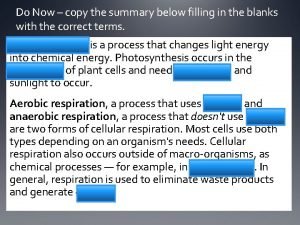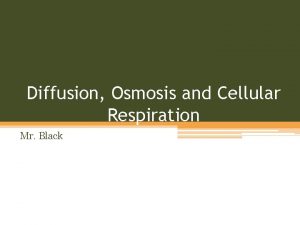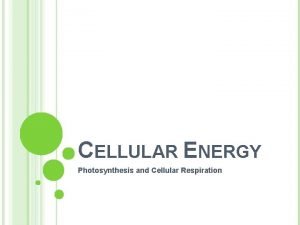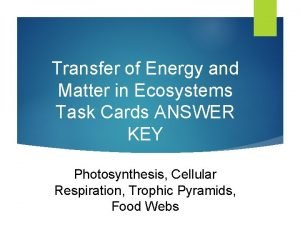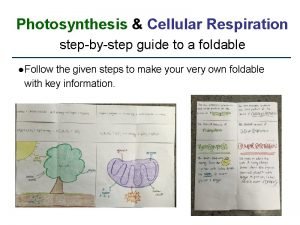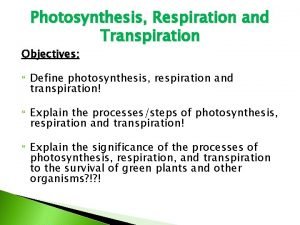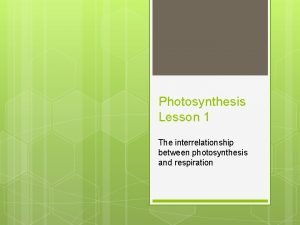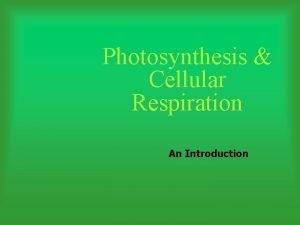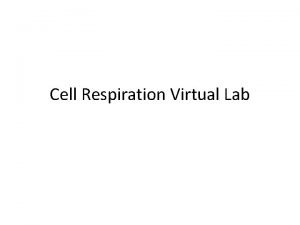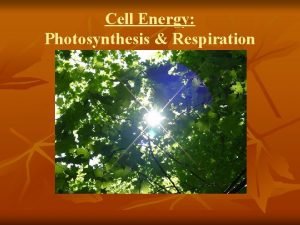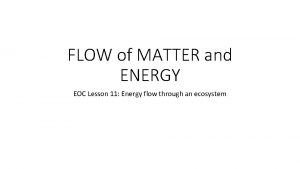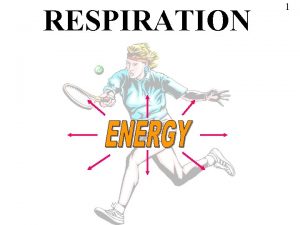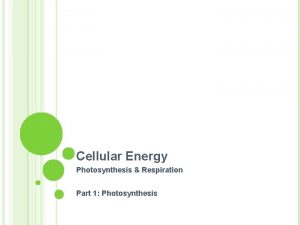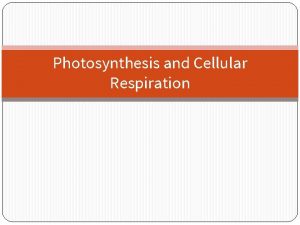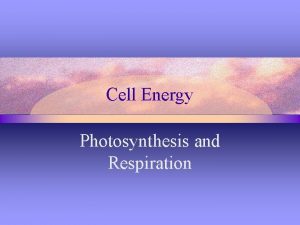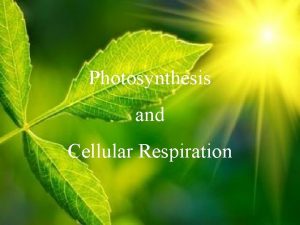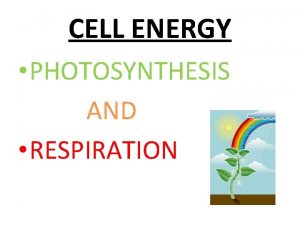Aquariums Miniature Oceans part 2 Photosynthesis Respiration and

















- Slides: 17

Aquariums – Miniature Oceans (part 2)

Photosynthesis, Respiration, and p. H Goals – Challenge students to link CO 2 concentrations and p. H values – Challenge students to think of photosynthesis as a sink for CO 2 and buffer against acidification – Expose students to simple experiments that connect respiration and CO 2 to increasing acid levels

Ocean Acidification • Increasing CO 2 leads to more carbonic acid (H 2 CO 3) and p. H of the ocean decreases • Impacts organisms with calcium carbonate components – Corals, Snails, some phytoplankton, etc… • This is a problem as trends in CO 2 production are increasing How could photosynthesis affect p. H in a closed system like an aquarium? If photosynthesis uses CO 2, CO 2 should decrease and p. H should increase (become more basic)

Activity 1 – Bromothymol Blue Assay • Add 50 m. L water to a clear bottle • Add ~20 drops of BTB or enough until solution becomes blue • Using a straw, gently blow into the solution for 30 seconds. The solution will become yellow, indicating that the solution has become a weak acid. • Do not inhale! Or drink the BTB solution

Activity 1 – Questions • How does our breath turn water into a weak acid? No, microbes and plants break • Is respiration done only by down organic matter with oxygen producing CO 2 (i. e. animals? respiration) • What other human activities produce CO 2? Why are they so impactful? Burning fossil fuels and deforestation. These disrupt the balance between photosynthesis and respiration, leading to excess CO 2

Activity 2 – Checking p. H between light and dark aquariums • Check p. H using test strips between the light and dark aquariums • Check p. H using a p. H probe Questions • Is there a difference between the two tanks? Why? • Is this difference large enough to make an impact on organisms or food webs?

Coral Dissections Goals • Introduce students to microbial symbioses and corals • Provide basic introduction on microscope use • Encourage students to think about the importance of organism interactions and their roles in ecosystem health (e. g. , why does bleaching occur? )

Coral – The great host • Micro – Zooxanthellae • photosynthesis – Bacteria • Antibacterials • Gut microbiome • Macro – Invertebrates – Fish Stained bacteria Photosynthetic zooxanthellae Anemone fish will host them As will shrimp and crabs

Coral Polyp Anatomy

The coral we’ll be working with Discosoma • Large polyp • No tentacles • Soft coral (does not have a calcium skeleton) • Common in the aquarium trade • Highly diverse Palythoa • Small polyp • Short thin tentacles • Soft coral (does not have a calcium skeleton) • Common in the aquarium trade • Highly diverse

Activity – Coral Dissection • Select 1 polyp of each specimen (Actinodiscus and Palythoa) • Examine structure of each intact coral under the dissection scope • Using a scalpel, carefully make an incision around the edge of the coral • Identify zooxanthellae symbionts

Coral Dissection – follow up questions • Are there any differences between zooxanthellae symbionts in the two species? • Why is coral bleaching an indicator of reef health? • Why is the symbiosis between the zooxanthellae and coral important?

Bioluminescence & Coral Fluorescence Goals • Introduce students to the topic of bioluminescence and fluorescence • Challenge students to critically think about biologically produced light in the oceans and its potential uses • Link microbial symbioses and bioluminescence to living strategies

Bioluminescence Videos https: //www. youtube. com/watch? v=9 HXXQBz 6 Vv 0 https: //www. youtube. com/watch? v=o. Kj. FVBVGad 0 What are some of the purposes of bioluminescence? Are bacteria the only organisms that can bioluminesce? Do you think it would be more/less beneficial to bioluminesce yourself, or to host bioluminscent bacteria in a symbiotic relationship? Cost/benefits?

Corals fluoresce under certain light wavelengths This a relatively common phenomenon, although the benefit of coral fluorescence remains unclear What are some potential reasons why corals fluoresce? Fluorescence

Activity • View a culture of Vibrio harveyi in the dark and discuss bioluminescence • View coral under 460 nm light to view fluorescence discuss fluorescence

Bioluminescence & Coral Fluorescence – Follow up questions • Does bioluminescence begin immediately after the lights go out? Why or why not? How does bioluminescence differ between V. harveyi in liquid culture, versus on agar plates? • Is all bioluminescence caused by symbionts? • What are the possible benefits to producing your own light in the deep ocean? • Compare benefits of deep bioluminescence to surface planktonic bioluminescence • How can predators and prey utilize bioluminescence? • Why would some corals reflect certain wavelengths of light to emit their own light? • What could be some drawbacks?
 Complementary processes
Complementary processes Formulas for cellular respiration
Formulas for cellular respiration What is cellular respiration equation
What is cellular respiration equation Venn diagram photosynthesis and respiration
Venn diagram photosynthesis and respiration Venn diagram photosynthesis and respiration
Venn diagram photosynthesis and respiration Function of cellular respiration
Function of cellular respiration Photosynthesis and cellular respiration diagram
Photosynthesis and cellular respiration diagram Photosynthesis and cellular respiration foldable
Photosynthesis and cellular respiration foldable Cellular respiration edpuzzle
Cellular respiration edpuzzle Photosynthesis definition
Photosynthesis definition Interrelationship between photosynthesis and respiration
Interrelationship between photosynthesis and respiration Photosynthesis and cellular respiration
Photosynthesis and cellular respiration Cell respiration virtual lab
Cell respiration virtual lab Photosynthesis and cellular respiration jeopardy
Photosynthesis and cellular respiration jeopardy Chapter 6 cell energy photosynthesis and respiration
Chapter 6 cell energy photosynthesis and respiration Internal respiration vs external respiration
Internal respiration vs external respiration Respiration
Respiration Photosynthesis or cellular respiration
Photosynthesis or cellular respiration



